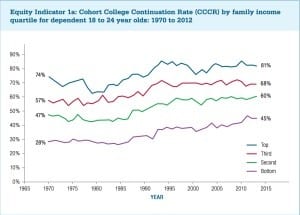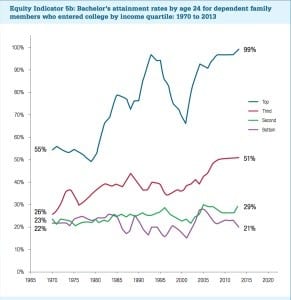 Public Purpose: The Blog of Campus Compact President Andrew Seligsohn
Public Purpose: The Blog of Campus Compact President Andrew Seligsohn
Fostering Student Success Across the Education Continuum
A new report from the Pell Institute for the Study of Opportunity in Higher Education at the University of Pennsylvania paints a clear picture of how deeply economic inequality is integrated into higher education in the United States.
The report shows that 18-24 year olds from the top income quintile are nearly twice as likely to enroll in post-secondary education as their counterparts from the bottom quintile. Young people from the top quintile are more than eight times as likely as young people from the bottom quintile to earn a bachelor’s degree by age 24. In 1970, those in the top quintile were five times as likely to earn a degree—so the gap is getting bigger quickly.
 Not surprisingly, part of the problem is that those who enter college from the top quintile are much more likely to graduate than those from the bottom quintile: 99% vs. 21%. In 1970, the corresponding figures were 55% vs. 22%. Over 45 years, we have gotten better and better at fostering success among the already successful, and we have made no measurable progress in fostering success among those seeking to advance to opportunity.
Not surprisingly, part of the problem is that those who enter college from the top quintile are much more likely to graduate than those from the bottom quintile: 99% vs. 21%. In 1970, the corresponding figures were 55% vs. 22%. Over 45 years, we have gotten better and better at fostering success among the already successful, and we have made no measurable progress in fostering success among those seeking to advance to opportunity. 
(And if you are tempted to wonder how much it matters whether one earns a bachelor’s degree, note that the unemployment rate for those with a bachelor’s degree is 2.8%, compared with 5.4% for those with only a high school diploma.)
These data capture the central reason why Campus Compact has identified as a top priority partnerships between higher education and communities aimed at fostering student success and civic learning across the education continuum. If colleges and universities are to achieve their public purposes, we must be actively involved in ensuring that students of all economic backgrounds have realistic pathways to college readiness, access, and success—and that all students who follow those pathways emerge prepared for lives of effective citizenship and professional success.
Related Content
Blog Posts
Engaged Campus
On Wisconsin
Blog Posts
Engaged Campus
Campus Compact’s Thirtieth Anniversary
Blog Posts
Engaged Campus
Are College Graduates Prepared to Suppor
More Public Purpose: The Blog of Campus Compact President Andrew Seligsohn
Blog Posts
Thirtieth Anniversary Action Statement
Blog Posts
Platform Partnerships
Blog Posts
An Observation About the Mission of High